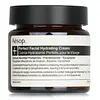What's inside
What's inside
 Key Ingredients
Key Ingredients

 Benefits
Benefits

 Concerns
Concerns

 Ingredients Side-by-side
Ingredients Side-by-side

Water
Skin ConditioningGlycerin
HumectantAloe Barbadensis Leaf Juice
Skin ConditioningButyrospermum Parkii Butter
Skin ConditioningGlyceryl Stearate
EmollientSimmondsia Chinensis Seed Oil
EmollientSodium Ascorbyl Phosphate
AntioxidantCetearyl Alcohol
EmollientRosa Canina Fruit Oil
EmollientSteareth-21
CleansingTheobroma Cacao Seed Butter
EmollientMicrocrystalline Cellulose
AbsorbentTocopherol
AntioxidantSorbitan Stearate
EmulsifyingPhenoxyethanol
PreservativeGlycine Soja Oil
EmollientBoswellia Carterii Oil
MaskingPEG-20 Stearate
EmulsifyingEthylhexylglycerin
Skin ConditioningHydroxyacetophenone
AntioxidantCitric Acid
BufferingFusanus Spicatus Wood Oil
MaskingRosmarinus Officinalis Leaf Oil
MaskingCellulose Gum
Emulsion StabilisingDisodium EDTA
Daucus Carota Sativa Root Extract
Skin ConditioningTropolone
Skin ConditioningBeta-Carotene
Skin ConditioningLimonene
PerfumingFarnesol
PerfumingLinalool
PerfumingWater, Glycerin, Aloe Barbadensis Leaf Juice, Butyrospermum Parkii Butter, Glyceryl Stearate, Simmondsia Chinensis Seed Oil, Sodium Ascorbyl Phosphate, Cetearyl Alcohol, Rosa Canina Fruit Oil, Steareth-21, Theobroma Cacao Seed Butter, Microcrystalline Cellulose, Tocopherol, Sorbitan Stearate, Phenoxyethanol, Glycine Soja Oil, Boswellia Carterii Oil, PEG-20 Stearate, Ethylhexylglycerin, Hydroxyacetophenone, Citric Acid, Fusanus Spicatus Wood Oil, Rosmarinus Officinalis Leaf Oil, Cellulose Gum, Disodium EDTA, Daucus Carota Sativa Root Extract, Tropolone, Beta-Carotene, Limonene, Farnesol, Linalool
Water
Skin ConditioningAlcohol Denat.
AntimicrobialHamamelis Virginiana Water
AstringentGlycereth-26
HumectantNiacinamide
SmoothingCoceth-7
EmulsifyingTrideceth-9
EmulsifyingPPG-1-PEG-9 Lauryl Glycol Ether
EmulsifyingPEG-5 Ethylhexanoate
EmulsifyingSorbitol
HumectantCamellia Sinensis Leaf Extract
AntimicrobialPanthenol
Skin ConditioningSodium Citrate
BufferingPEG-40 Hydrogenated Castor Oil
EmulsifyingPhenoxyethanol
PreservativeLavandula Angustifolia Oil
MaskingDisodium EDTA
Salicylic Acid
MaskingOrmenis Multicaulis Oil
MaskingRosmarinus Officinalis Leaf Oil
MaskingSalvia Officinalis Oil
MaskingBenzoic Acid
MaskingCitric Acid
BufferingLinalool
PerfumingLimonene
PerfumingWater, Alcohol Denat., Hamamelis Virginiana Water, Glycereth-26, Niacinamide, Coceth-7, Trideceth-9, PPG-1-PEG-9 Lauryl Glycol Ether, PEG-5 Ethylhexanoate, Sorbitol, Camellia Sinensis Leaf Extract, Panthenol, Sodium Citrate, PEG-40 Hydrogenated Castor Oil, Phenoxyethanol, Lavandula Angustifolia Oil, Disodium EDTA, Salicylic Acid, Ormenis Multicaulis Oil, Rosmarinus Officinalis Leaf Oil, Salvia Officinalis Oil, Benzoic Acid, Citric Acid, Linalool, Limonene
Ingredients Explained
These ingredients are found in both products.
Ingredients higher up in an ingredient list are typically present in a larger amount.
Citric Acid is an alpha hydroxy acid (AHA) naturally found in citrus fruits like oranges, lemons, and limes.
Like other AHAs, citric acid can exfoliate skin by breaking down the bonds that hold dead skin cells together. This helps reveal smoother and brighter skin underneath.
However, this exfoliating effect only happens at high concentrations (20%) which can be hard to find in cosmetic products.
Due to this, citric acid is usually included in small amounts as a pH adjuster. This helps keep products slightly more acidic and compatible with skin's natural pH.
In skincare formulas, citric acid can:
While it can provide some skin benefits, research shows lactic acid and glycolic acid are generally more effective and less irritating exfoliants.
Most citric acid used in skincare today is made by fermenting sugars (usually from molasses). This synthetic version is identical to the natural citrus form but easier to stabilize and use in formulations.
Read more about some other popular AHA's here:
Learn more about Citric AcidDisodium EDTA plays a role in making products more stable by aiding other preservatives.
It is a chelating agent, meaning it neutralizes metal ions that may be found in a product.
Disodium EDTA is a salt of edetic acid and is found to be safe in cosmetic ingredients.
Learn more about Disodium EDTALimonene is a fragrance that adds scent and taste to a formulation.
It's found in the peel oil of citrus fruits and other plants such as lavender and eucalyptus. The scent of limonene is generally described as "sweet citrus".
Limonene acts as an antioxidant, meaning it helps neutralize free radicals.
When exposed to air, oxidized limonene may sensitize the skin. Because of this, limonene is often avoided by people with sensitive skin.
The term 'fragrance' is not regulated in many countries. In many cases, it is up to the brand to define this term. For instance, many brands choose to label themselves as "fragrance-free" because they are not using synthetic fragrances. However, their products may still contain ingredients such as essential oils that are considered a fragrance.
Learn more about LimoneneLinalool is a fragrance and helps add scent to products. It's derived from common plants such as cinnamon, mint, citrus, and lavender.
Like Limonene, this ingredient oxidizes when exposed to air. Oxidized linalool can cause allergies and skin sensitivity.
This ingredient has a scent that is floral, spicy tropical, and citrus-like.
Learn more about LinaloolPhenoxyethanol is a preservative that has germicide, antimicrobial, and aromatic properties. Studies show that phenoxyethanol can prevent microbial growth. By itself, it has a scent that is similar to that of a rose.
It's often used in formulations along with Caprylyl Glycol to preserve the shelf life of products.
Rosmarinus Officinalis Leaf Oil is oil expressed from the leaves of the rosemary plant.
Rosemary Leaf Oil is a fragrance and helps give your product a scent. If you are sensitive to irritating fragrances, this one contains camphor. Camphor has been found to irritate skin.
This oil also contains antioxidant and antimicrobial properties. As an antioxidant, it may protect you skin against damage. This can help slow down the signs of aging.
Learn more about Rosmarinus Officinalis Leaf OilWater. It's the most common cosmetic ingredient of all. You'll usually see it at the top of ingredient lists, meaning that it makes up the largest part of the product.
So why is it so popular? Water most often acts as a solvent - this means that it helps dissolve other ingredients into the formulation.
You'll also recognize water as that liquid we all need to stay alive. If you see this, drink a glass of water. Stay hydrated!
Learn more about Water